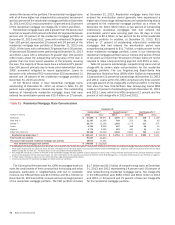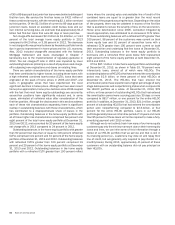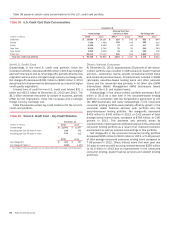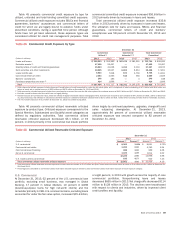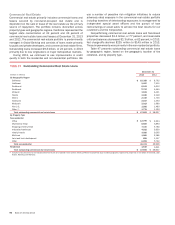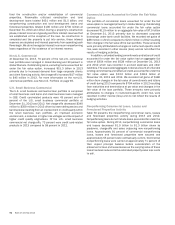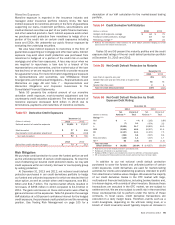Bank of America 2013 Annual Report Download - page 89
Download and view the complete annual report
Please find page 89 of the 2013 Bank of America annual report below. You can navigate through the pages in the report by either clicking on the pages listed below, or by using the keyword search tool below to find specific information within the annual report.
Bank of America 2013 87
We classify junior-lien home equity loans as nonperforming
when the first-lien loan becomes 90 days past due even if the
junior-lien loan is performing. At December 31, 2013 and 2012,
$1.2 billion and $1.5 billion of such junior-lien home equity loans
were included in nonperforming loans and leases.
Table 42 presents TDRs for the home loans portfolio.
Performing TDR balances are excluded from nonperforming loans
in Table 41.
Table 42 Home Loans Troubled Debt Restructurings
December 31
2013 2012
(Dollars in millions) Total Nonperforming Performing Total Nonperforming Performing
Residential mortgage (1, 2) $ 29,312 $ 7,555 $ 21,757 $ 28,125 $ 9,040 $ 19,085
Home equity (3) 2,146 1,389 757 2,125 1,242 883
Total home loans troubled debt restructurings $ 31,458 $ 8,944 $ 22,514 $ 30,250 $ 10,282 $ 19,968
(1) Residential mortgage TDRs deemed collateral dependent totaled $8.2 billion and $9.4 billion, and included $5.7 billion and $6.4 billion of loans classified as nonperforming and $2.5 billion and
$3.0 billion of loans classified as performing at December 31, 2013 and 2012.
(2) Residential mortgage performing TDRs included $14.3 billion and $11.9 billion of loans that were fully-insured at December 31, 2013 and 2012.
(3) Home equity TDRs deemed collateral dependent totaled $1.4 billion and $1.4 billion, and included $1.2 billion and $1.0 billion of loans classified as nonperforming and $227 million and $348
million of loans classified as performing at December 31, 2013 and 2012.
We work with customers that are experiencing financial difficulty
by modifying credit card and other consumer loans, while complying
with Federal Financial Institutions Examination Council (FFIEC)
guidelines. Credit card and other consumer loan modifications
generally involve a reduction in the customer’s interest rate on the
account and placing the customer on a fixed payment plan not
exceeding 60 months, all of which are considered TDRs (the
renegotiated TDR portfolio). In addition, non-U.S. credit card
modifications may involve reducing the interest rate on the account
without placing the customer on a fixed payment plan, and these
are also considered TDRs (also a part of the renegotiated TDR
portfolio).
In all cases, the customer’s available line of credit is canceled.
We make modifications primarily through internal renegotiation
programs utilizing direct customer contact, but may also utilize
external renegotiation programs. The renegotiated TDR portfolio
is excluded in large part from Table 41 as substantially all of the
loans remain on accrual status until either charged off or paid in
full. At December 31, 2013 and 2012, our renegotiated TDR
portfolio was $2.1 billion and $3.9 billion, of which $1.6 billion
and $3.1 billion were current or less than 30 days past due under
the modified terms. The decline in the renegotiated TDR portfolio
was primarily driven by paydowns and charge-offs as well as lower
program enrollments. For more information on the renegotiated
TDR portfolio, see Note 4 – Outstanding Loans and Leases to the
Consolidated Financial Statements.
Commercial Portfolio Credit Risk Management
Credit risk management for the commercial portfolio begins with
an assessment of the credit risk profile of the borrower or
counterparty based on an analysis of its financial position. As part
of the overall credit risk assessment, our commercial credit
exposures are assigned a risk rating and are subject to approval
based on defined credit approval standards. Subsequent to loan
origination, risk ratings are monitored on an ongoing basis, and if
necessary, adjusted to reflect changes in the financial condition,
cash flow, risk profile or outlook of a borrower or counterparty. In
making credit decisions, we consider risk rating, collateral, country,
industry and single name concentration limits while also balancing
this with total borrower or counterparty relationship. Our business
and risk management personnel use a variety of tools to
continuously monitor the ability of a borrower or counterparty to
perform under its obligations. We use risk rating aggregations to
measure and evaluate concentrations within portfolios. In addition,
risk ratings are a factor in determining the level of allocated capital
and the allowance for credit losses.
For information on our accounting policies regarding
delinquencies, nonperforming status and net charge-offs for the
commercial portfolio, see Note 1 – Summary of Significant
Accounting Principles to the Consolidated Financial Statements.
Management of Commercial Credit Risk
Concentrations
Commercial credit risk is evaluated and managed with the goal
that concentrations of credit exposure do not result in undesirable
levels of risk. We review, measure and manage concentrations of
credit exposure by industry, product, geography, customer
relationship and loan size. We also review, measure and manage
commercial real estate loans by geographic location and property
type. In addition, within our non-U.S. portfolio, we evaluate
exposures by region and by country. Tables 47, 52, 60 and 61
summarize our concentrations. We also utilize syndications of
exposure to third parties, loan sales, hedging and other risk
mitigation techniques to manage the size and risk profile of the
commercial credit portfolio.
As part of our ongoing risk mitigation initiatives, we attempt to
work with clients experiencing financial difficulty to modify their
loans to terms that better align with their current ability to pay. In
situations where an economic concession has been granted to a
borrower experiencing financial difficulty, we identify these loans
as TDRs.
We account for certain large corporate loans and loan
commitments, including issued but unfunded letters of credit
which are considered utilized for credit risk management purposes,
that exceed our single name credit risk concentration guidelines
under the fair value option. Lending commitments, both funded
and unfunded, are actively managed and monitored, and as
appropriate, credit risk for these lending relationships may be
mitigated through the use of credit derivatives, with the
Corporation’s credit view and market perspectives determining the
size and timing of the hedging activity. In addition, we purchase
credit protection to cover the funded portion as well as the
unfunded portion of certain other credit exposures. To lessen the
cost of obtaining our desired credit protection levels, credit
exposure may be added within an industry, borrower or
counterparty group by selling protection. These credit derivatives



